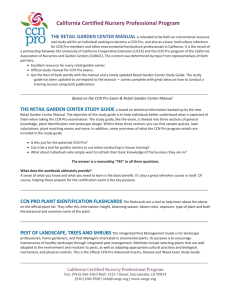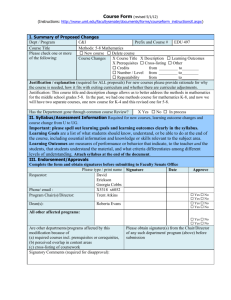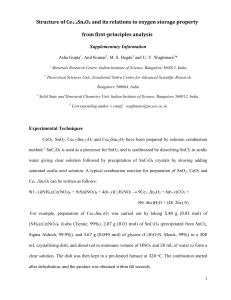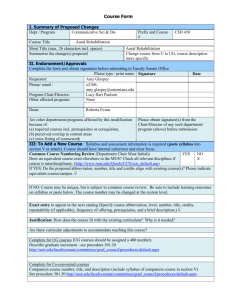201.05 Common Course Numbering Workflow / Timeline
advertisement
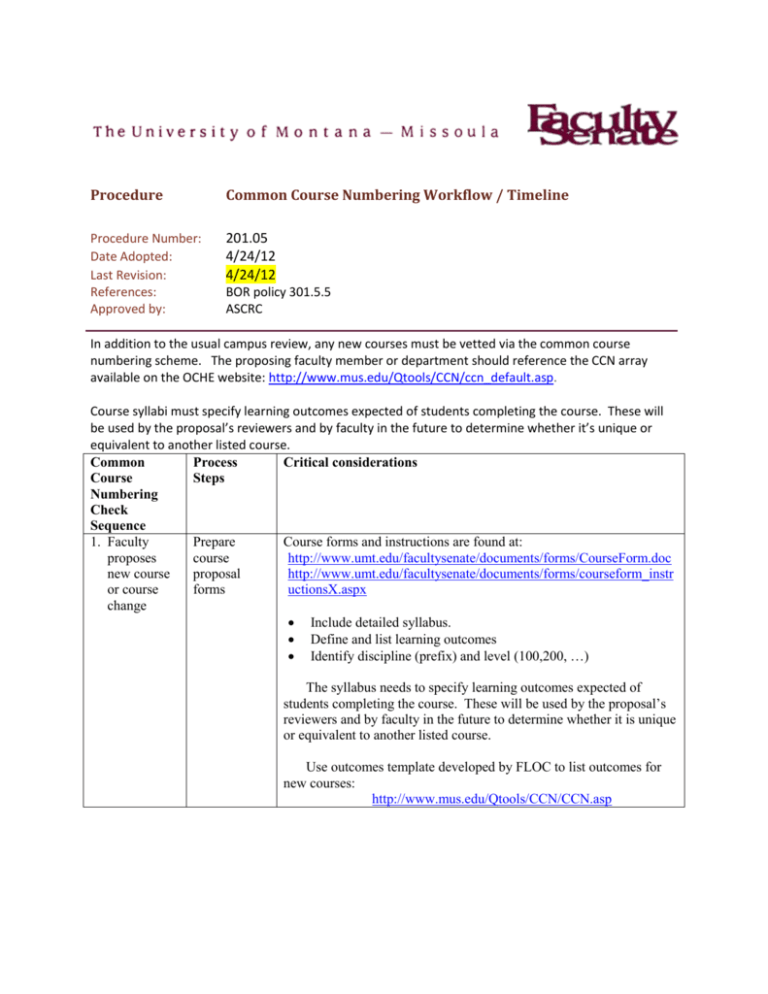
Procedure Common Course Numbering Workflow / Timeline Procedure Number: Date Adopted: Last Revision: References: Approved by: 201.05 4/24/12 4/24/12 BOR policy 301.5.5 ASCRC In addition to the usual campus review, any new courses must be vetted via the common course numbering scheme. The proposing faculty member or department should reference the CCN array available on the OCHE website: http://www.mus.edu/Qtools/CCN/ccn_default.asp. Course syllabi must specify learning outcomes expected of students completing the course. These will be used by the proposal’s reviewers and by faculty in the future to determine whether it’s unique or equivalent to another listed course. Common Process Critical considerations Course Steps Numbering Check Sequence 1. Faculty Prepare Course forms and instructions are found at: proposes course http://www.umt.edu/facultysenate/documents/forms/CourseForm.doc new course proposal http://www.umt.edu/facultysenate/documents/forms/courseform_instr or course forms uctionsX.aspx change Include detailed syllabus. Define and list learning outcomes Identify discipline (prefix) and level (100,200, …) The syllabus needs to specify learning outcomes expected of students completing the course. These will be used by the proposal’s reviewers and by faculty in the future to determine whether it is unique or equivalent to another listed course. Use outcomes template developed by FLOC to list outcomes for new courses: http://www.mus.edu/Qtools/CCN/CCN.asp 2. Faculty check for similarity to existing courses at UM Search catalog Contact affected departments Has the similar UM course undergone CCN revision? Yes: Are proposed syllabus and Learning Outcomes 80% similar? Rationalize proposed course with existing course. Similar course offerings must bear same prefix and number. Affected department(s) must sign-off on proposed course No: Complete course preparation forms as new course. 3. Faculty check for similarity to courses in CCN database. For new or revised course, search CCN database for similar courses Has the MUS discipline gone through the CCN review / renumbering process? Yes: check the array of courses for potential equivalencies as needed, contact offering faculty/departments and/or FLOC members to get more details http://www.mus.edu/Qtools/CCN/ccn_default.asp. Does the course appear to be equivalent to another listed in the array? Verify the apparent equivalency in terms of similar learning outcomes (75-80%?) If equivalency seems confirmed, assign existing CCN discipline, title, and number to course If not equivalent, review the array and assign unique title and number to ensure a logical “fit” of the new entry in the array 4. Department Head / Dean reviews proposed change 5. ASCRC and Transfer Liaison reviews proposed change 6. Campus Approval 7. Notification of UM action Review CCN for alignment issues (et al.) Review proposal for certification of review for CCN alignment issues. No: proceed as you always have. Verifies that faculty has complied with CCN procedures. http://www.mus.edu/Qtools/CCN/CCN.asp Considers alternative disciplinary alignments that might reveal unanticipated equivalencies that could raise concerns both on campus and elsewhere in the system. Consent agendas are approved by Faculty Senate usually at the Nov / Dec meetings Departments notified of completion of internal review during winter break. OCHE provided with list of new and changed courses to incorporate into the array. 8. Notification of OCHE Learning outcomes entered into OCHE’s database. OCHE informs University Point of Contact and Registrar’s Office of CCN review determination and courses are entered into the catalog and action (CCN) and Final approval set up in Banner. Departments are notified of any changes that arise from the internal review.




